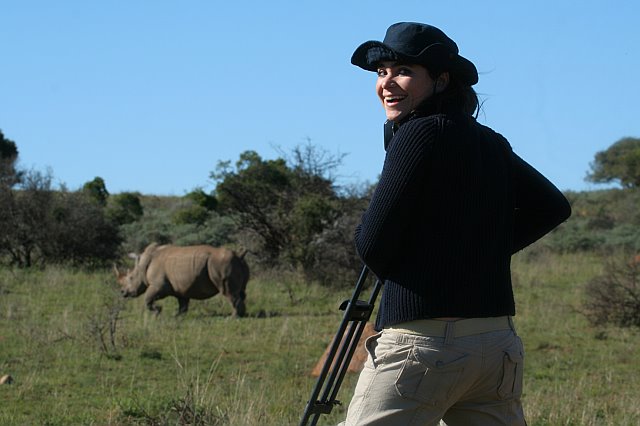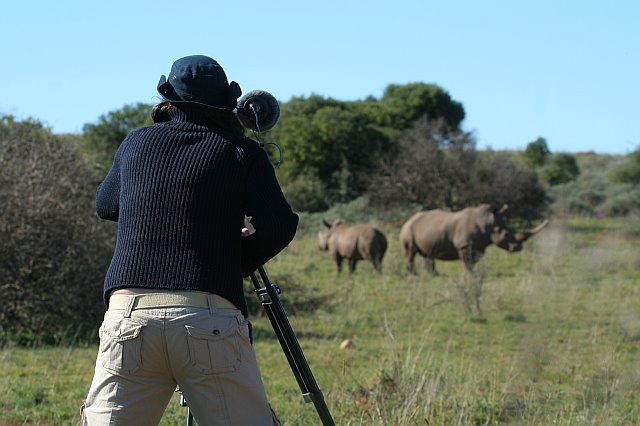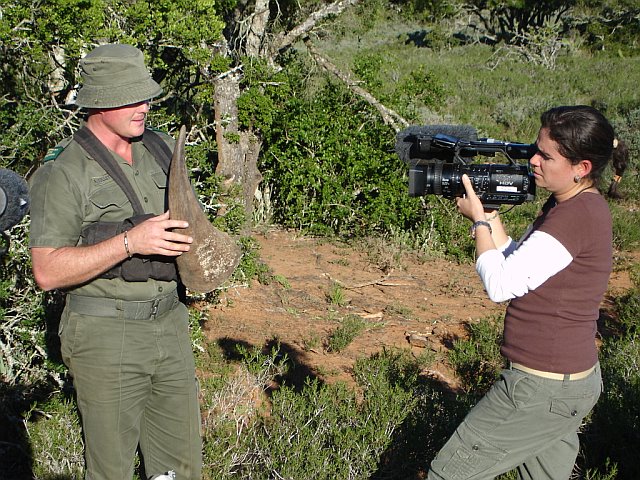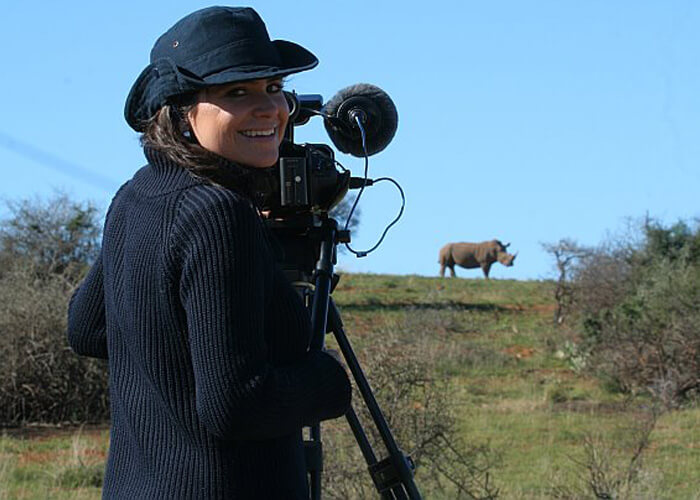The first time I stepped in Africa it felt like arriving where I always belonged, where I was supposed to be. I immediately fell in love with its sky, the smell of the earth, the wind scented by elephants, lions, antelopes or rhinos, depending on the time of the day. I fell in love with its infinite landscapes, the sensation of absolute freedom. I feel in love with the sound of my heart, beating like an African drum.
Africa was all over my body with a single breath…

Filming white rhino at Shamwari Game Reserve, South Africa. Photograph: Dave Olsen, 2006.
Unearthed
In 2006, I had the privilege to visit Shamwari Game Reserve, South Africa, to take part on a “docu-reality” TV show for Animal Planet called Unearthed. During three weeks, six amateur filmmakers from around the globe, (me being one of them) were chosen from 34,000 applications.
The purpose of this show was to teach us all about wildlife filmmaking and, in the last week, the six of us had to direct, write, film and edit our own documentary. Every day we had intensive courses on camera, editing, script writing and, of course, African wilderness. This was a dream come true, I’ve always loved nature, so filming African animals in their habitat was more than I could ask for.

Lyndal Davies, (center) was the host for Unearthed. I used to watch her every weekend on Animal Planet. Six months after this show, I returned to South Africa to work on her production company, Rock Wallaby Productions. (I’m the one in front of her, in the blue hat).
Whenever I’m asked what’s my favorite animal, I find myself thinking of hundreds. I start thinking about wolves, but then I remember humpback whales, orcas, elephants, lions, mantas, hammerhead sharks… dogs! So it is quite impossible for me to give a one word answer. I can’t pick a favorite. What I can say, though, is that the animal that changed my life was the rhinoceros.
It happened a morning. We were all editing when a sudden entrance of Lyndal Davies to the room, followed by Andrew Barron, Director of the series, made us all jump from our chairs. “Guys, there’s been a call, there might be some poachers on the reserve”, said Lyndal.
I’ve never ever heard that word before. “Poachers?”, I thought… “what is that”? So I had to ask. Poachers are illegal hunters.
I ran to grab my camera, changed the tape to a new one and replaced the battery.
“We need this, we need this”, said Andrew.
If I’m going to die, it has to be recorded
We all jumped on the Land Rovers and I pressed the REC button. I started filming thinking that I couldn’t miss a shot. There was no room for mistakes, specially considering that if I was going to die to the hands of poachers, it had to be recorded.
Darius Schoultz, our ranger, was driving fast while giving us instructions: “always stay together, follow our lead, don’t put yourselves on any danger” and so on. I just wanted to arrive and hunt these hunters down. On the radio, someone said words in Zulu or Xhosa that I couldn’t understand.
We spot smoke in the distance. All vehicles stopped, I can’t remember how many, I just kept filming. “There’s a very strong chance that these people will have guns, ok?”, Lyndal said. “Anyone at this point who doesn’t want to come along, please, please stay behind, and we won’t look at you any differently”.
As she was talking, I could see Shamwari’s Anti Poaching Unit team running behind her, disappearing into the thick bush. I couldn’t wait to run with them.

Filming white rhino at Shamwari Game Reserve, South Africa. Photograph: Dave Olsen, 2006.
We were given “green light” and we all started running to catch up with the Anti Poaching Unit team. Antony Collett, the one in charge, was standing next to the fire where the smoke was coming from. They left minutes before we arrived and had no time to erase their tracks. They were close. As my anger grew I decided to leave this emotion aside and instead keep filming. I approached Antony and asked some questions for him to answer on camera.
We ran again. We arrived to a point with thick bush. Darius turned to us and, with his left hand, indicated that they spotted them, and there were two. We all docked down. I kneeled down to keep recording as much as I could. Andrew, kneeling in front of me, was telling me something that I can’t remember. A gunshot. Then, three gun shots. I kept filming. Lyndal asked us to wait, she didn’t want to put us on any danger.
“Ok, go!”, said Andrew. And I ran like I’ve never ran before in my life. I ran like if it was up to me to save the lives of all the rhinoceros in Africa, of all the elephants, lions, leopards, giraffes. And I kept filming, I had to see the look on their faces and expose them in one of the most internationally renowned TV channels.
Today, in 2022, the price of an Asian rhino horn is
USD$400,000 PER KILOGRAM.
The price of an African rhino horn is USD$
$20,000 PER KILOGRAM.
The white bag
Two men lying in the soil, with their hands tied on their back, were hiding their faces. We all stopped in front of Antony, who was holding a white bag in his hand. “What were they after, let’s have a look, guys, get this shot”, Lyndal said.
The bag wasn’t even open, and I could already feel the biggest pain that I’ve ever felt in my chest. I knew that what we were about to film was going to be the life of a creature tragically taken. I was right. “It’s rhino horns, guys”, Lyndal confirmed.
These words made me dizzy. I felt like if someone just threw freezing water on me while crying like never before. I lost all composure. I forgot my mother’s advice at the airport: “Don’t cry on camera, make us all proud”. As I was crying and mumbling words in Spanish, I turned to see these two men with two rifles pointing at them. I wanted to run and kick them in the face, but my mother’s voice stopped and remembered that I was being filmed. So, with all the strength left in my chest, I screamed: “I hope you rot in hell!”.

Antony Collett holding a white rhino while interviewing him.
I could barely stand on my feet. As I kept filming and holding onto the camera with my right hand, with my left hand I was pushing my knee to keep myself up. “Ok, Karla, look at me sweetie.”, Lyndal said while bringing me up. “Look at me, this has been an exercise, it’s called The Poaching Drill, ok? We’ve done it to see who had the guts to actually be a wildlife filmmaker, and you my girl, you win”. I finally stopped recording.
Complete sequence, here:
The Reality
What we experienced in this sequence was a drill, but the reality is that rhinos are still being killed for their horns. It is believed in countries like Vietnam that the rhino horn has medicinal properties, which, by the way, has no scientific proof. Meanwhile, in China, they use the horn to create “art” pieces.
According to IUCN Red List of Threatened Species, these are the current status of rhinos:
- White Rhinoceros: Nearly Threatened. More information, here.
- Black Rhinoceros: Critically Endangered. More information, here.
- Sumatran Rhinoceros: Critically Endangered. More information, here.
- Javan Rhinoceros: Critically Endangered. More information, here.
When rhinos changed my life
This drill for the show changed my life in many ways. Not only did I opened my eyes to an issue that I was ignorant about, but it also taught me the power that each and one of us have to change the fate of species like the rhinoceros. It doesn’t matter if I’m in Mexico, I care about Rhinos like I care for the Mexican Grey Wolf or the Vaquita Marina. I care because each and every single creature on Earth, matters. Each plays a vital role and if one of them disappears, we will, too.
In March 2007, I returned to Shamwari Game Reserve, South Africa, to be part of Lyndal Davie’s Film crew. I had three months to prove myself to her and, fortunately, those 3 months turned into 3 years. I owe this to the rhinos.
World Rhino Day
Today, on World Rhino Day, I would like to dedicate this blog to the rangers that risk their lives protecting this magnificent creature. I want to thank international organizations who dedicate their efforts onto protecting rhinos, and I want to acknowledge private reserves like Shamwari who are keeping rhinos safe while also giving them the home they deserve.
With love,
Karla


